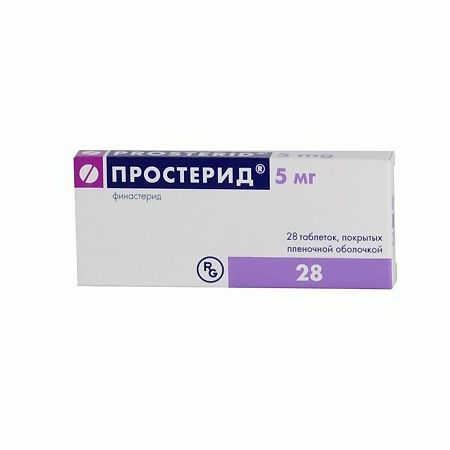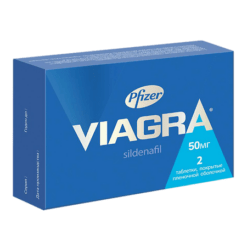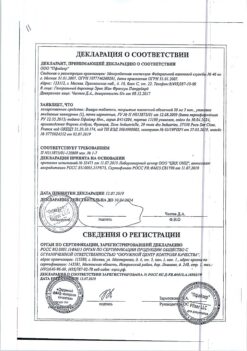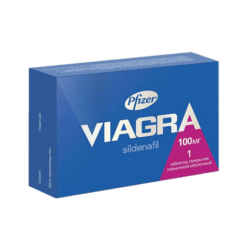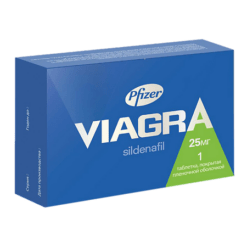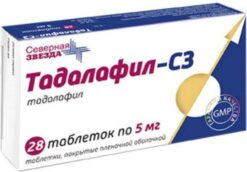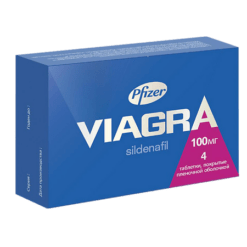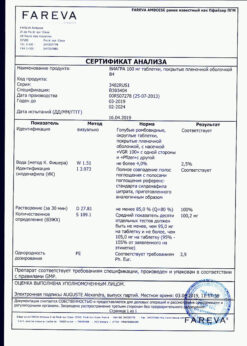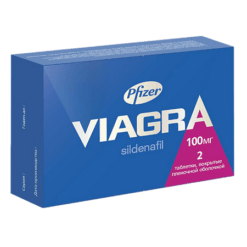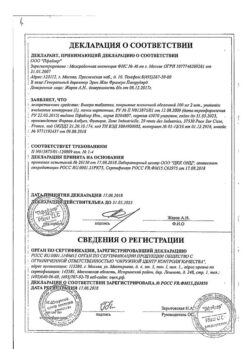No products in the cart.
Prosteride, tablets 5 mg, 28 pcs.
€1.00
Out of stock
(E-mail when Stock is available)
Description
Prosteride has antiandrogenic effects.
Pharmacodynamics
Finasteride is a synthetic 4-azasteroid compound, a competitive and specific inhibitor of the steroid 5-a-reductase type II isoenzyme, which converts testosterone to the active androgen 5-a-dihydrotestosterone (DHT). Finasteride interferes with the stimulating effect of testosterone on tumor development; inhibition of dihydrogenase formation is accompanied by a reduction in prostate volume, an increase in maximum urine outflow rate, and a decrease in symptoms of urinary tract obstruction. At constant reception the statistically significant effect is registered after 3 months (reduction of volume of the gland) and 7 months. (reduction in the severity of symptoms associated with prostatic hyperplasia).
There are 2 types of 5-a-reductase in the human body: I and II. Their distribution in tissues is not the same: in the prostate, testicles and their appendages, penis head, scrotum, seminal vesicles, liver and chest, type II isoenzyme is found; type I is found mainly in the scalp, back and chest, sebaceous glands, liver, adrenal glands and kidneys. Finasteride primarily inhibits type II isoenzyme, which is responsible for most of the DHT in the blood. A single dose of finasteride rapidly and significantly alters plasma levels of DHT. A single 5 mg dose of finasteride reduces plasma levels of DHT by 75%, which reaches its lowest level at 24 hours, then returns to baseline within 7 days.
In multiple doses, finasteride remains effective. Finasteride reduces DHT levels in the prostate itself by
Prostat-specific antigen (PSA) is a sensitive and specific androgen-dependent marker of prostate carcinoma. In most cases, there is a rapid decrease in PSA levels after several months of treatment with finasteride and then a new baseline.
After 1 year of taking 5 mg doses of finasteride, the average PSA concentration drops by 50%.
Finasteride has no affinity for androgen receptors and no other hormonal action. Following the discovery of 5-a-reductase and the description of 5-a-reductase deficiency syndrome type II (male hermaphroditism), the role of androgens in benign prostatic hyperplasia has been reconsidered. Prostate development depends on DHT, a strong androgen. In 5-a-reductase deficiency against a background of normal or high testosterone levels in adulthood, prostatic atrophy is observed.
DHT activates androgen receptors, forming dimers after attachment to them, which, binding to DNA, directly or indirectly promote cell proliferation by changing expression of genes responsible for proliferation and apoptosis. In intact prostate the processes of apoptosis and proliferation are in equilibrium. Despite the fact that the factors provoking prostatic hyperplasia at the molecular level are not known, the role of DHT in this is very probable. Specific type II 5-a-reductase inhibitors are able to reduce prostate levels of DHT and promote the reversal of prostatic hyperplasia. There was significant lethality in mice and rats of both sexes when the first single dose of finasteride, equal to 1500 mg/msup>2 (500 mg/kg), and to the latter 2360 mg/m2 (400 mg/kg for females) and 5900 mg/m2 (1000 mg/kg for males). Low doses of the drug fed to pregnant rats caused genital malformations in male offspring.
Pharmacokinetics
Absorption: rapidly absorbed from the gastrointestinal tract, reaching maximum plasma concentration of 37 ng/ml in 2 hours. There is no significant difference in the elimination half-life and time of maximum concentration in multiple dosing or after it. No cumulation is observed during 7-day dosing, the saturation stage occurs after 4 days. Food intake does not affect absorption and plasma concentration. Bioavailability: 80%.
Distribution: decreased renal function does not affect the binding to plasma proteins, which is 90%. Finasteride penetrates well into tissues and biological fluids, including brain, and into sperm. When infusing 5 mg of finasteride for 1 h, the volume of distribution is 76±14 l.
Metabolism: it undergoes intensive metabolism (oxidation) in the liver. Among the 5 metabolites 2 are active, their inhibitory activity is 20% of that of finasteride.
Elimation: the elimination half-life is independent of the dose and is 4.7-7.1 h. The biological effect of a single dose lasts for approximately 4 days. Plasma clearance: 164±55 ml/min. About 39% (32%-46%) is excreted in the urine as metabolites, “57% (51%-64%) – with feces. 0.04% ±0.02% of the dose is excreted unchanged in the urine and 0.01% – with feces. The concentration of finasteride in semen ranges from undetectable (< 1 ng/ml) to 21 ng/ml.
Long-term, 3-7-month administration at a dose of 5 m/day reduces serum 5a-DHT concentrations by 70% in croe.
Indications
Indications
Benign prostatic hyperplasia (to reduce the size of the prostate gland, increase maximum urine flow rate and reduce symptoms associated with hyperplasia, reduce the risk of acute urinary retention and the associated likelihood of surgery).
Active ingredient
Active ingredient
Composition
Composition
Active ingredient:
Finasteride 5 mg;
Associates:
Magnesium stearate,
talc,
sodium carboxymethyl starch (type A),
Pregelatinized starch,
Microcrystalline cellulose,
Lactose monohydrate;
Composition of the film coating:
titanium dioxide,
lactose monohydrate,
macrogol 6000,
hydroxypropylcellulose,
hypromellose
How to take, the dosage
How to take, the dosage
It is intended exclusively for men.
Normal daily dose: 1 tablet (5 mg), for at least 6 months.
Elderly age: no change in dose is necessary, despite delayed elimination from the body (about 8 hours).
Renal failure: no dose reduction is required since excretion is primarily with the feces; the main kinetic parameters (elimination half-life, maximum concentration, AUC) are similar to those of healthy subjects.
Special Instructions
Special Instructions
Before starting treatment with finasteride, the presence of diseases simulating benign prostatic hyperplasia should be excluded: prostatic cancer, urethral stricture, hypotension of the bladder, impaired innervation, infectious prostatitis. The improvement is not immediate, therefore if there are large residual volumes of urine or severe forms of difficulty in urination, it is advisable to monitor the patient to prevent the development of obstructive uropathy.
Finasteride causes a 48% decrease in PSA 12 months after administration (even in the simultaneous presence of prostatic carcinoma), making it difficult to recognize prostatic carcinoma, so a preliminary rectal digital examination of the organ is recommended, then repeated periodically during treatment to rule out the presence of carcinoma.
Low doses of finasteride can cause abnormal development of the external genitalia in the male fetus if the drug enters the body of a pregnant woman by any route. The amounts of finasteride absorbed by touch with a broken pill or with the semen of a man who has taken finasteride are unknown.
To avoid affecting the male fetus, pregnant women and women suspected of being pregnant should not touch broken finasteride pills or the semen of men treated with the drug. Due to the fact that it remains unknown how long after the end of treatment finasteride continues to be excreted with sperm, it is recommended that men continue to take precautions for 2 months after the end of treatment. It is recommended that laboratory tests of liver and kidney function and urine sediment be performed before treatment and every 6 months during treatment.
Contraindications
Contraindications
Hypersensitivity to the ingredients of the drug, prostate cancer, urinary tract obstruction, childhood.
With caution: hepatic insufficiency.
Side effects
Side effects
Possible gynecomastia, painful breasts, sometimes hypersensitivity reactions (lip swelling, skin rash), increased concentration of luteinizing and follicle stimulating hormones in the blood (about 10%, while they remain within normal limits).
Similarities
Similarities
Additional information
| Shelf life | 3 years |
|---|---|
| Conditions of storage | In a light-protected place at 15-30 °C |
| Manufacturer | Gedeon Richter, Hungary |
| Medication form | pills |
| Brand | Gedeon Richter |
Related products
Buy Prosteride, tablets 5 mg, 28 pcs. with delivery to USA, UK, Europe and over 120 other countries.

